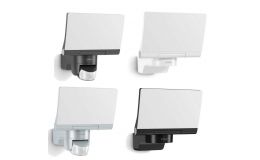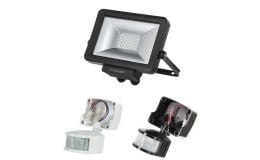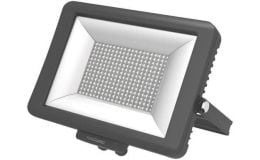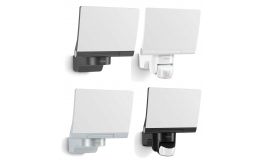Fastlec uses cookies to ensure that we give you the best experience on our website. If you continue we assume that you consent to receive all cookies on the Fastlec website. Read More.
Floodlights
LED Floodlighting: A Comprehensive Overview
Introduction
LED floodlighting is a modern, energy-efficient, and versatile lighting solution that has become increasingly popular in recent years. Floodlights are designed to provide wide, even illumination over large areas, making them ideal for a range of applications, including security, sports fields, outdoor events, architectural accents, and more. LED technology has revolutionized the floodlighting industry by offering numerous benefits over traditional lighting methods, such as increased energy efficiency, longer lifespans, and lower maintenance costs. This category description will delve into the various aspects of LED floodlighting, including its working principles, applications, benefits, and the factors to consider when selecting the right LED floodlight for your needs.
Working Principles of LED Floodlighting
LED floodlights use light-emitting diodes (LEDs) as their light source. LEDs are semiconductor devices that emit light when an electric current passes through them. Compared to traditional light sources like incandescent and halogen bulbs, LEDs are much more energy-efficient, producing more light per watt and generating less heat. LED floodlights typically consist of multiple LEDs combined in a single fixture to achieve the desired level of brightness and coverage.
Applications of LED Floodlighting
- Security and Safety: LED floodlights are commonly used to enhance the safety and security of residential and commercial properties. Their bright, wide-reaching illumination discourages intruders and helps occupants navigate outdoor spaces safely during nighttime hours.
- Sports Fields and Facilities: LED floodlights provide optimal illumination for outdoor sports fields, such as football, soccer, baseball, and tennis courts. They ensure clear visibility for athletes and spectators, improving the overall experience and facilitating better performance.
- Outdoor Events: LED floodlights are an excellent choice for lighting outdoor events, including concerts, festivals, and weddings. They provide even, glare-free illumination, creating a comfortable and inviting atmosphere for guests.
- Architectural and Landscape Accent Lighting: LED floodlights can be used to highlight the architectural features of buildings or to create dramatic lighting effects in landscaping. They can also be used for illuminating pathways, gardens, and other outdoor areas, enhancing the aesthetic appeal of a property.
- Industrial and Commercial Applications: LED floodlights are widely used in industrial and commercial settings, such as warehouses, factories, parking lots, and loading docks, where bright, consistent lighting is necessary for safety and productivity.
Benefits of LED Floodlighting
- Energy Efficiency: LEDs consume significantly less energy than traditional lighting sources, leading to lower electricity bills and reduced greenhouse gas emissions.
- Long Lifespan: LED floodlights can last up to 50,000 hours or more, reducing the need for frequent replacements and minimizing maintenance costs.
- Durability: LED floodlights are built to withstand harsh weather conditions and are resistant to shock, vibrations, and temperature fluctuations, making them ideal for outdoor use.
- Instant On/Off: Unlike some traditional lighting sources, LED floodlights turn on instantly and do not require a warm-up period. They are also compatible with dimming and control systems, allowing for greater flexibility in lighting design.
- Environmentally Friendly: LEDs do not contain hazardous materials, such as mercury, and produce less heat than traditional lighting sources, reducing their impact on the environment.
Selecting the Right LED Floodlight
When choosing an LED floodlight for your application, consider the following factors:
- Brightness and Coverage: Determine the required brightness (measured in lumens) and coverage area based on the intended application. Higher lumen output means a brighter light, while a wider beam angle provides more coverage.
- Colour Temperature: LED floodlights are available in various colour temperatures, ranging from warm white (2700K) to cool white (6500K). Select the colour temperature that best suits your application and desired ambience. Warm white is often used for residential and architectural accent lighting, while cool white is typically preferred for sports fields, security lighting, and industrial applications.
- IP Rating: The Ingress Protection (IP) rating indicates the level of protection a floodlight has against dust and water ingress. Choose an LED floodlight with an appropriate IP rating for your specific environment and application. For example, an IP65-rated floodlight is suitable for outdoor use, as it is dust-tight and can withstand low-pressure water jets.
- CRI (Color Rendering Index): CRI is a measurement of a light source's ability to reproduce colours compared to natural light accurately. A higher CRI value indicates better colour rendering, which is particularly important for applications where accurate colour representation is crucial, such as in retail or gallery spaces.
- Efficiency and Wattage: Consider the energy efficiency of the LED floodlight, measured in lumens per watt (lm/W). A higher lm/W value indicates a more energy-efficient light. Additionally, ensure that the wattage of the floodlight is suitable for your specific requirements, taking into account the desired brightness and coverage area.
- Mounting Options: LED floodlights come in various mounting options, such as ground, wall, or pole mounting. Choose the appropriate mounting option based on the location and application of the floodlight.
- Control and Dimming: Some LED floodlights are compatible with control systems, allowing for remote operation, scheduling, and dimming. Consider whether these features are necessary for your application and ensure the selected floodlight supports them.
- Warranty and Support: Lastly, always consider the warranty and support offered by the manufacturer or supplier. A longer warranty period and responsive support services indicate a higher level of confidence in the product's quality and durability.
Conclusion
LED floodlighting has transformed the landscape of outdoor illumination, offering a range of benefits over traditional lighting technologies. With their high energy efficiency, long lifespan, and versatility, LED floodlights are an excellent choice for a wide array of applications. By considering the factors outlined in this description, you can select the ideal LED floodlight to meet your specific needs and enjoy the many advantages of this modern lighting solution.
- In stock
- In stock
-
3 Days Delivery
- In stock
- In stock
-
3 Days Delivery
- In stock
- In stock
- In stock
- In stock
- In stock
-
3 Days Delivery













